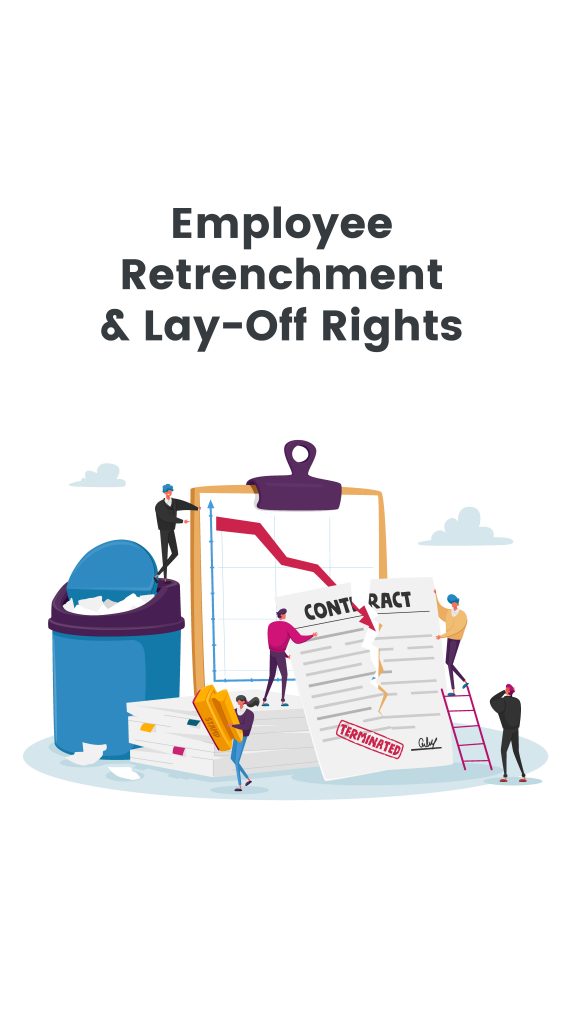A common query which often arises is whether an employer can terminate any of his employee at his will? Or what are the legal procedures an employer must follow before terminating an employee? Is there any difference between termination and lay-off of an employee? Or are both one and the same? Many of these questions regarding employee retrenchment and lay-off are connected to the Industrial Disputes Act 1947, and will all be answered in this article.
Table of Contents
Who is a Workman?
The Industrial Disputes Act 1947 is applicable on a “Workman” and not an “employee”. According to their definition, a “workman” stands for any person (including an apprentice) employed in any industry to do any manual, unskilled, skilled, technical, operational, clerical or supervisory work for hire or reward, whether the terms of employment be express or implied.
In simple terms, any person, who is working full-time or as an apprentice, doing any level of skill labour in an industry, and having his terms of employment clearly stated, will be counted as a “workman”.
Exceptions to workman
The following categories of people are not implicitly categorized as a “workman”:
- All Air Force/ Army/ Navy personnel
- anyone in police service
- anyone who is employed mainly in a managerial or administrative capacity
- any supervisor who draws wages exceeding Rs 10,000 per month
Overall, a workman is not decided just by their designation in the company. One’s nature of work and duties are taken into account to finalize if they fall under workman category or managerial.
What is Employee Lay-off?
“Lay-off” by definition means the failure, refusal or inability of an employer to give employment to a workman who’s name is in the muster roll. This means that due to some reason, the employer is unable to give any task to his employee who is on the pay roll. So the employer is unable to pay him his salary as well. Lay-off does not mean that the employee is fired from his job since lay-off is a temporary state.
Reasons for lay-off
Some of the common reasons for lay-off can be as follows, which basically put the production of goods in the factory to a halt:
- shortage of power supply to the factory
- shortage of raw material to the factory
- accumulation of stocks in the factory
- break-down of machinery in the factory
- a natural calamity
Rules for lay-off of employees
- The lay-off must be justified. Additionally, it must be bona fide and not mala fide. Bona fide means in good faith and Mala fide means with the wrong intention. The company must produce a valid reason for laying off its employees and not do it just because it is convenient for them.
- Muster roll of all employees must be maintained even during lay-off duration.
- The employer must give all details regarding the lay-off to the employee. Such as how long the lay-off duration will be, whether employees should remain at the place of work or return to their hometown, when shall the employee restart work, whether the employee must register his presence at the company every day, etc.
- Employer must give the employee 3 weeks time to rejoin his duties post lay-off.
- Employees have to be compensated 50% of their Basic+DA wages for a period of up to 45 days in the last 12 months.
- If retrenchment/termination needs to be done post lay off, the employee’s compensation can be set off against the compensation payable for retrenchment.
What is Employee Retrenchment?
“Retrenchment” by definition means the termination by the employer of the service of a workman for any reason whatsoever, other than as a punishment inflicted by way of disciplinary action. Thus, if an employee is terminated for any reason other than as a disciplinary action for any wrongdoing on his behalf, it is counted as retrenchemnt.
Exceptions for retrenchment
Retrenchment will not be counted in the following cases:
- Voluntary retirement of the workman.
- Retirement of the workman due to old age.
- Termination of the service of the workman as a result of the non-renewal of the contract.
- Termination of the service of a workman on the ground of continued ill-health.
When is retrenchment allowed?
Retrenchment is allowed for any reason as per the Industrial Disputes Act 1947. As long as it is fair, justifiable and done with proper legal procedures. Some common reasons for retrenchment can be business restructuring, economical crisis, loss of a big project, etc.
What are the duties of employer during retrenchment?
It is important for the employer to follow these rules during retrenchment of an employee, else the retrenchment is considered void and the employee will have to be reinstated to his duties. These rules are as follows:
- The employee must receive 1-month’s notice period or 1-month’s compensation before retrenchment.
- The notice of retrenchment must contain a clear date of termination of the employee.
- Employee must also receive a compensation equivalent of 15 days for every completed year of his service in excess of 6 months.
Rules for retrenchment of employees
- Rule 25D states that a proper muster roll of the employee is maintained along with his retrenchment date.
- Rule 77 states that a list of all employees in a particular department has to be arranged in seniority order from which retrenchment is contemplated.
- Additionally, rule 25G states that once the seniority order list is made, the employer has to follow the ‘last in, first out’ rule. Thus, the newest 5 joinees have to be considered for retrenchment first before going on to more senior employees. If there is some specific reason for retrenchment of senior members, then that is allowable.
- Lastly, rule 25F states that if employer has to rehire for that same position then he must ask the retrenched employee first for hire first. If the employee refuses, then employer can look at new candidates for hire.
If these rules are not followed, the retrenchment will be void and the employee can be reinstated, if employer is contested in court.
Special rules for 100+ workers
In some companies the rules for retrenchment get even stricter. Especially in case of factories, mines and plantation with over 100 workmen, the rules for retrenchment are as follows:
- Layoff or retrenchment must be done with government approval, Central or State as the case may be. A notice has to be sent to the government informing them of the need for lay-off or retrenchment. Upon approval from the government, the employer can go ahead.
- The notice period for retrenchment is 3 months instead of one month in such cases.
- Retrenchment can not be due to victimisation.
If above rules are not properly followed then the retrenchment or layoff stands void and canceled.

What if an employee does not fall under the ‘workman’ category?
In case an employee does not fall under the “workman” category then lay-off or retrenchment can be done as per the employment contract terms. The rules of compensation will abide by the terms given in the contract. However, if the contract terms unfavourably side with the employer and leave the employee helpless then the issue can be raised to court. These can be specific employee bond terms which you can learn in detail in This is how you can break an employment bond with a company.
Other termination compensation/benefits
- If employee has been in service for over 5 years then he is liable for gratuity upon retrenchment. Learn more about gratuity in How much gratuity money will I get?
- The employee is entitled to receive leave encashment for all the leaves he has accumulated. Learn about the various types of leaves in How Many Earned Leaves As Per Law?
- If employee has worked for more than 30 days in that financial year then he is eligible for a bonus. Learn more about bonus calculation in Payment of bonus act.
What is the difference between Retrenchment and Resignation?
Many times companies insist their employees to put in their resignation instead of terminating their service. This is due to the fact that retrenchment or termination incurs various rules and regulations which the company must comply with. Hence, to make things easier for them, companies opt for employees submitting their resignation rather than retrenchment. This is wrong on the part of the company and employee can contest this in court. For more details, read Leaving A Job? Know The Important Jargon.
Watch the video below for more information on job termination terms.
Join the LLA telegram group for frequent updates and documents.
Download the telegram group and search ‘Labour Law Advisor’ or follow the link – t.me/JoinLLA
It’s FREE!


